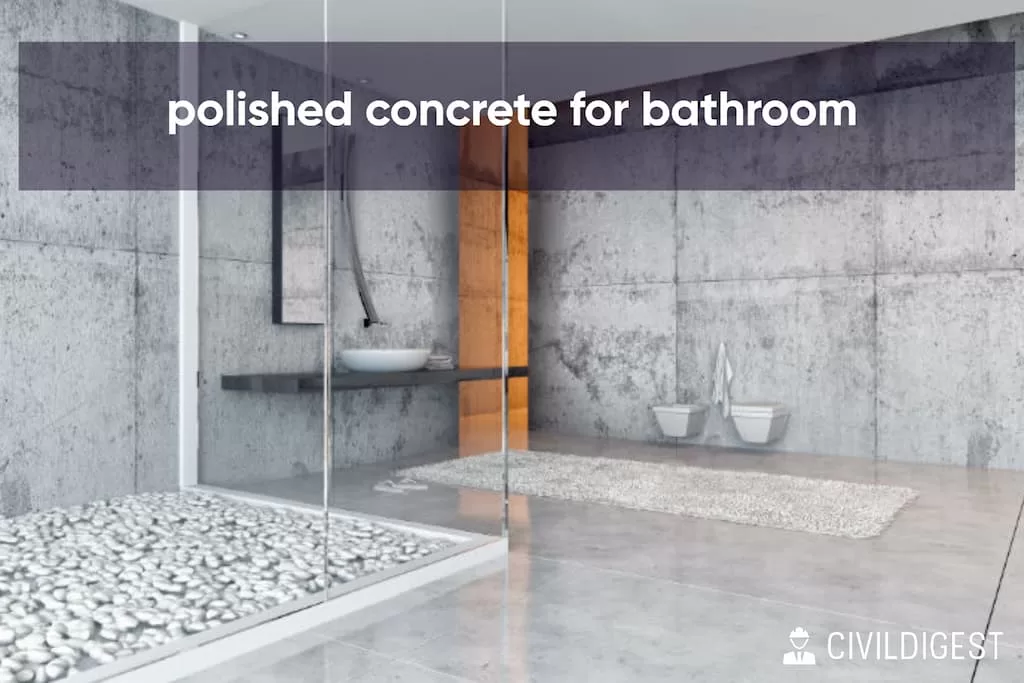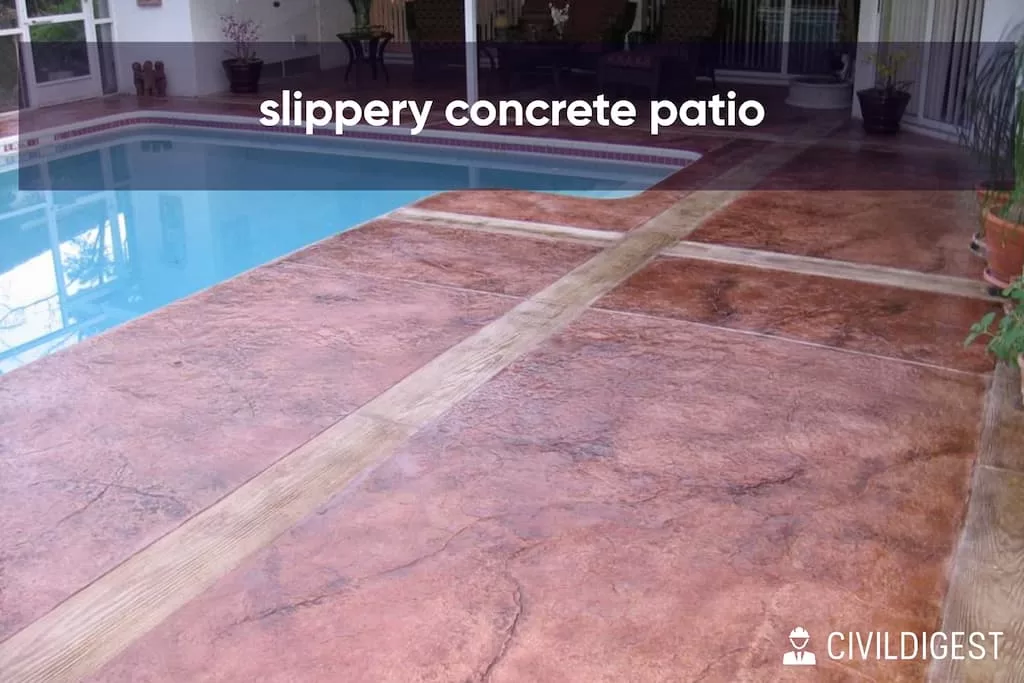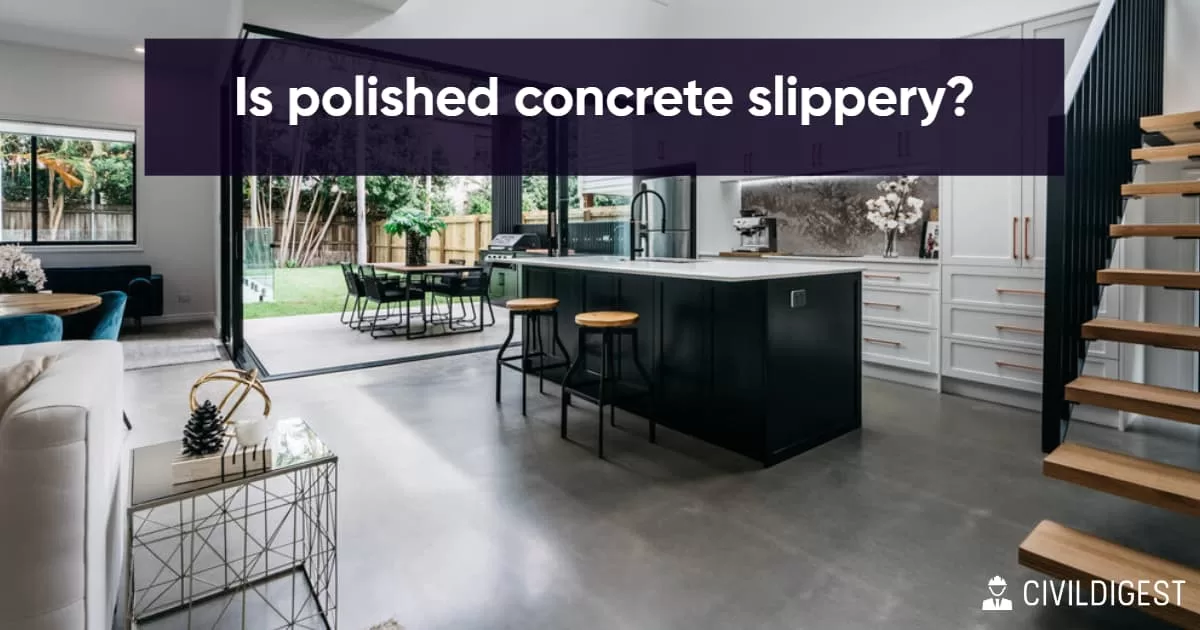Polished concrete is generally not slippery, especially when dry, making it a popular choice for its slip-resistant properties.
However, its porous nature means that water doesn’t immediately wipe up, leading to temporary damp spots that could pose slipping risks. It’s also worth noting that the presence of oils and chemicals on its surface can enhance its slipperiness. But, with appropriate measures, such as applying slip-resistant coatings or installing non-slip mats, the potential hazards can be mitigated.
This article explains polished concrete, its advantages, drawbacks, and practical ways to make it less slippery, ensuring you make an informed decision for your next construction or DIY project.
Table of Contents
Understanding Polished Concrete
Polished concrete has gained fame as both a material of beauty and functionality. It’s not just a plain surface; it’s a durable and aesthetically pleasing option for various spaces. Let’s delve into what it is and examine its ups and downs.
What is polished concrete?
Polished concrete is a multi-step process where a concrete floor is mechanically ground, honed, and polished with bonded abrasives to cut a concrete floor’s surface.
This process refines the surface to a shiny, smooth finish. Special chemicals known as “densifiers” are added to harden the surface. The result is a floor that’s not only good-looking but also strong and durable.
To clarify, let’s break down some technical terms:
- Mechanically Ground: This means the surface is ground down with specialized machinery.
- Bonded Abrasives: These are materials used to cut or shape the surface, like diamond tips.
- Densifiers: Chemicals that make the surface harder and less porous.

In a recent project for a manufacturing facility, we transitioned from an epoxy floor to polished concrete. The transformation was not just aesthetic; it significantly reduced the maintenance overhead.
| Aspect | Details |
| Material | Concrete |
| Process | Mechanical Grinding, Honing, Polishing |
| Additives | Densifiers |
| Finish | Smooth, Shiny Surface |
| Strength | High |
Polished concrete floors pros and cons
As with any material, polished concrete has its share of advantages and disadvantages.
Advantages of polished concrete floors
- Durability: These floors are incredibly long-lasting. They can endure heavy traffic without showing wear and tear.
- Low Maintenance: A simple sweep and mop are generally enough to keep these floors clean.
- Cost-Effectiveness: Although the initial setup might be expensive, long-term maintenance costs are low.
- Aesthetic Versatility: They can be stained or dyed to create various effects, fitting multiple design schemes.
- Eco-Friendly: Concrete is a sustainable material, and polishing it doesn’t require extra materials or substances that can harm the environment.
Real-World Example
In a retail store, a polished concrete floor can handle the heavy footfall and still last for years. When it comes to cleaning, a quick sweep each day and a weekly mop can keep it looking brand new.
Disadvantages of polished concrete floors
- Initial Cost: The setup involves specialized machinery and skilled labor, which can be expensive.
- Hardness: While durable, the hard nature can be tough on joints if you’re standing for extended periods.
- Cold: The material doesn’t retain heat well, making it cold to the touch.
- Noise: It can amplify sounds, making it less ideal for quiet settings like libraries.
- Slipperiness: If not treated properly, polished concrete can be slippery, especially when wet.
Real-World Example
In a home environment, you might find the floors uncomfortable if you stand on them for too long, say, while cooking. You might also notice a chilly feel on winter mornings.
So there you have it. Both sides of the coin when it comes to polished concrete floors. Weigh these pros and cons carefully to see if this type of flooring is the right choice for you.
Polished Concrete in Different Environments
Polished concrete isn’t a one-size-fits-all solution. How it performs can vary depending on where it’s used
Is polished concrete slippery in the bathroom?
Polished concrete in a bathroom is a trendy choice. However, it’s critical to understand its slip resistance. Yes, polished concrete can be slippery when wet, a common situation in bathrooms.

Coefficient of Friction (CoF)
Firstly, let’s talk about the Coefficient of Friction (CoF). It’s a measure of how slippery a surface can get. The American National Standards Institute (ANSI) has guidelines that a surface must have a CoF greater than or equal to 0.42 to be considered “slip-resistant.”
Let’s say, for instance, your polished concrete floor has a CoF of 0.35 when wet. According to ANSI standards, this floor would not be considered safe for wet environments like bathrooms. You’d want to apply some anti-slip treatment to bring that number up.
Precautions
If you’re keen on having polished concrete in your bathroom, you’ll want to consider:
- Applying anti-slip sealers
- Using bath mats in high-risk areas like near the bathtub or shower
- Regularly checking the CoF if your bathroom is frequently wet
Is polished concrete better than tiles?
Comparing polished concrete with tiles involves several factors—cost, aesthetics, durability, and maintenance.
| Criteria | Polished Concrete | Tiles |
| Cost | Lower upfront cost | Varies |
| Aesthetics | Modern, sleek | Multiple design options |
| Durability | High | Medium |
| Maintenance | Low | Moderate |
Real-World Example:
In a cafe with high foot traffic, polished concrete floors are often chosen for their durability. Tiles, on the other hand, could be a choice for a home bathroom where aesthetic variations are desired.
How do you fix a slippery concrete patio?
A slippery patio can be a hazard, especially during wet seasons. Here are some actionable steps to make your polished concrete patio less slippery.

Anti-Slip Methods:
- Texture Coating: Apply a textured coating that gives more grip.
- Anti-Slip Additives: These can be mixed directly into sealer or paint.
- Use Rubber Mats: Place mats in high-traffic areas.
- Sand Broadcasting: Sprinkle sand over the wet sealer to create a gritty texture.
I once had a client with a large concrete patio that became slippery when wet. We opted for a textured coating with anti-slip additives. The result? An immediate increase in slip resistance, particularly during wet conditions.
Addressing Slipperiness in Polished Concrete
Slipperiness in polished concrete is a concern that should never be swept under the rug. It’s crucial for safety, especially in areas prone to moisture.
How do you make polished concrete less slippery?
Polished concrete is widely used in commercial buildings, warehouses, and even homes. But, its sleek appearance comes with a downside: it can be quite slippery. So how can we fix that?
Anti-slip conditioners for polished concrete
Anti-slip conditioners are liquid treatments. You can apply them to the surface of polished concrete. They create a microscopic texture. This adds grip, making the floor less slippery.
| Type | Pros | Cons |
| Penetrating Sealers | Long-lasting, clear finish | Needs professional application |
| Film-Forming Sealers | Quick and easy application | Requires frequent reapplication |
How to Apply
- Clean the Surface: Get rid of any debris or grease.
- Apply Conditioner: Use a mop or sponge for application.
- Let it Dry: Give it time, usually 24 hours.

How do you rough up smooth concrete?
Sometimes, it’s necessary to rough up a polished concrete surface to make it safer. This can be especially crucial in public spaces, workplaces, and homes. How do you do that effectively?
Mechanical Methods
1. Sandblasting
- How it works: High-pressure air and sand particles are aimed at the concrete surface.
- Outcome: Creates a textured surface.
- Real-world example: Often used in skateparks and industrial settings.
2. Grinding
- How it works: Using a diamond grinding machine to wear down the surface.
- Outcome: Achieves a rough texture.
- Real-world example: Common in shopping malls.
Chemical Methods
1. Acid Etching
- How it works: Applying a mild acid solution to eat away at the smooth surface.
- Outcome: Leaves a rough texture.
- Real-world example: Typically used in garage floors.
2. Anti-Slip Additives
- How it works: Mixed into the concrete sealer before application.
- Outcome: Provides a grittier surface.
- Real-world example: Pool decks.
Best Practices for Roughing Up Concrete
- Safety First: Always wear protective gear.
- Test Patch: Always test a small area first.
- Follow Guidelines: Adhere to manufacturer instructions.

Are polished concrete floors high maintenance?
Polished concrete floors are often praised for their low maintenance and longevity, but they’re not entirely hassle-free. The common perception that they are “maintenance-free” isn’t completely accurate.
| Floor Type | Maintenance Level | Lifespan |
| Polished Concrete | Low to Moderate | 20+ years |
| Hardwood | Moderate to High | 10-20 years |
| Carpet | High | 5-15 years |
The durability of a polished concrete floor largely depends on its maintenance. Though less frequent, maintenance tasks are crucial to sustain its lifespan.
Polished concrete maintenance tips
Taking care of polished concrete is simpler than you may think. Here are some foolproof tips based on my own experience in managing large-scale projects.
Daily Cleaning
- Sweep Daily: Use a dust mop to catch everyday dirt and dust.
- Spot Clean: Wipe up spills as soon as they happen to prevent stains.
Weekly Cleaning
- Wet Mop: Use a pH-neutral cleaner and a flat microfiber mop.
- Check for Damage: Inspect for any cracks or chipped areas.
List of Cleaning Supplies
- Dust mop
- Microfiber mop
- pH-neutral cleaner
Periodic Maintenance
- Burnishing: This is a high-speed polishing action that rejuvenates the surface. Done quarterly or semi-annually.
- Re-Applying Sealer: If your floor has a topical sealer, it may need to be reapplied annually to maintain its luster.
Conclusion
Polished concrete has made its mark in both residential and commercial spaces for its sleek look and durability. However, slipperiness remains a concern. Our exploration took us through understanding polished concrete, examining its performance in various environments, and learning how to address its potential slipperiness.
We also delved into the maintenance aspect and weighed the pros and cons of using it over other flooring options like tiles. Anti-slip conditioners and surface roughening techniques can effectively combat slipperiness, offering both short-term and long-term solutions.












